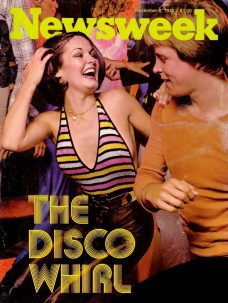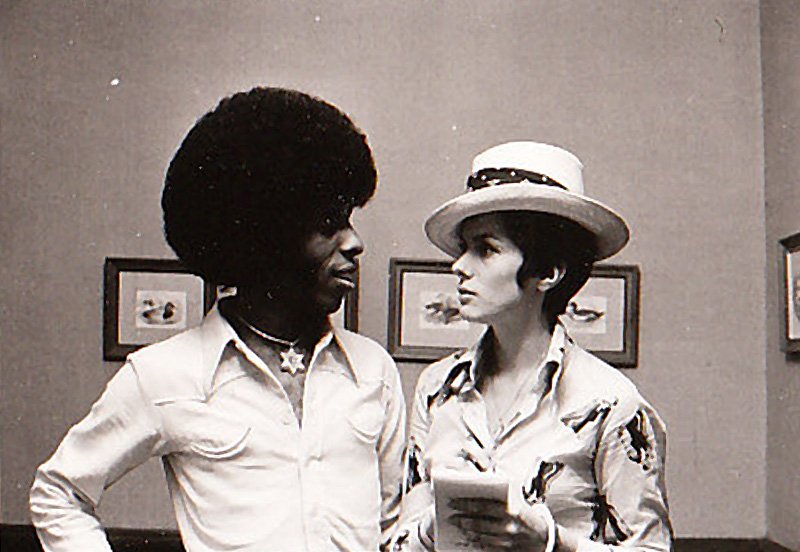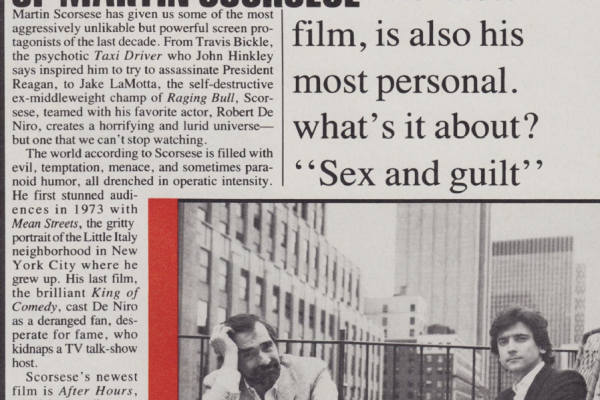It’s “Island of Paradise” night at the Enchanted Garden disco in Douglaston, N.Y., with hula girls, palm trees, a 70-pound roasted pig and a fire dancer working himself into a charcoal-broiled frenzy. Each week, the converted eleven-room mansion, built on a golf course, changes its decor and throws a theme party for its 2,000 regulars. The luau comes between the “Arabian Nights” party – featuring llamas, camels and a snake charmer – and “Hooray for Hollywood” night when the dance-floor Charlies get into their Fred Astaire fantasies. Every night, patrons can sample the game room, complete with backgammon, electronic pong and pool, or visit the love-nest room, furnished with bedsize couches and a gazebo full of stuffed birds – installed after $4,000 worth of live ones died from the constantly changing temperatures.
In the ladies’ room, 21-year-old Yolanda Cimino, a bookkeeper, and her girlfriend, a typist, are using one of the seven blow driers and hairbrushes thoughtfully provided by the management. The girls come to the Enchanted Garden two or three times a week, but neither one has ever met a boy she has dated for any period of time. “What I like about dancing here is that you don’t have to talk to the guy,” says Yolanda, who spent three hours getting dressed for the evening. In the men’s room, Johnny Boy Musto, 18, an attendant at Shea Stadium, and his buddy, Ray Muccio, a packer for a hamburger franchise, are blow-drying their hair after spending an hour and a half on their toilette at home. Johnny Boy is wearing a black body shirt, half-unbuttoned, several gold chains around his neck and tight-fitting beige pants. “It’s very important you don’t wear the same thing for at least four weeks,” he says, earnestly checking himself in the mirror one last time.
If it sounds like throwback to Archie and Veronica, it is – but with the latest in technological trappings. Good Grooming and touch dancing are back in. Small talk and the strain of the singles bar are out. Discos are where it’s happening. With an estimated 10,000 in the U.S. today – compared with about 1,500 just two years ago – discos have become one of the biggest entertainment phenomena of the ’70s. And the chance to boogie again is appealing to the Beautiful People, the bourgeoisie and the blue-collar worker alike. Discos are opening – and closing – in everything from Holiday Inns and Hilton hotels to rural potato barns and Bloomingdale’s basement. There are kiddie discos, senior-citizen discos, rollerskating discos and discos on wheels, which carry their canned music and lights to suburbia. Disco franchisers talk about becoming “the McDonald’s of the entertainment business.”
The new disco-mania goes far beyond the discotheque. It has brought back dressy clothes and dance lessons and made disco deejays into local celebrities. Discos have also profoundly influenced the giant pop-music industry by creating a special disco sound, a vast new market for records and a new all-disco format for radio stations. They have also launched a number of disco-turned-pop stars like Barry White, the Silver Convention, Gloria Gaynor and Donna Summer. (Last week, no fewer than five of Billboard’s top ten singles were disco-oriented hits.)
There is a whiff of scary futurism in the current craze. Discos have popularized totally programed environments – and the result is canned sensuality. A contemporary disco is not only a place to let go, to be seen and to watch, it is also an environment where technology throws a cloak of nonthreatening anonymity over insecurities and hangups. While sex is everywhere implied, discos are often curiously asexual. There is no stigma attached to girls dancing with girls or boys with boys – and no compulsion to find a mate. For some, discos are an Antonioni film on non-communication come to life. For others, they are a harbinger of the Somazonked masses of 1984. And for a generation raised on TV rock and drugs, a generation that takes technology for granted, discos provide the same kind of spectacle and glamour that normally surround a superstar. “At a disco, the record buyer can be the rock star,” says singer-composer Barry White, who has sold 22 million records in three years after getting his start in discos. “People can dressup in the baddest fashions and look like they’re in somebody’s group. The hippest mother gets a shot at stardom at the disco.”
In a pace-setting Sun Belt city like Atlanta, the disco functions as a multimedia melting pot. At predominantly black and swinging cisco’s disco, leading figures in the local news come in once a week to speak and answer questions. “Here,” say Jim Wright, publisher of Lovely Atlanta magazine, “discos have been the most viable means politicians and businessmen have found to meet the necessary people they need to make their businesses go.” In Detroit, discos are one of the few places where blacks and whites truly mingle. “I’ve been prejudiced all my life and only now am I beginning to relax with blacks,” says Morrie Levine, who drops in at downtown Detroit’s L’Esprit. “People feel comfortable here.” “Disco is the greatest thing that ever happened to restaurants,” says Ron Briskman, a Chicago restaurateur-turned-disco entrepreneur. “The Loop is dead in night, but suddenly, with discos happening, we’re busy every night. We just take away the tables. It’s a new source of income.”
On Saturday afternoons, Briskman sells out a 10,000-square-foot kiddie disco called Dingbats. For $2.50, toddlers to 14-year-olds can get a dance lesson and launch – a choice of the Hustling Hamburger, the Groovy Grilled Cheese or Raggedy Ann Disco Salad. In Los Angeles, the Coco-Bowl disco caters to those who used to dance to the bigband sound of the ’30s and ’40s. While Glenn Miller originals spin on the turntable, a three-hour slide show projects photographs of the old bandleaders, singers and sidemen, and the middle-aged crowd bets grocery money to see who can identify Woody Herman at 35. Recently, a couple in their 20s sheepishly approached an older woman and her partner. “How do you do it?” they asked. “We want to dance like you.” “We showed them a few basic two-steps,” reports middle-ager Helen Robak, “and told them to keep trying.” Everywhere else, the dance in the disco world is the hustle, with dozens of other dances like the bus stop, the rope and the roach trailing behind. “We have 700 students learning to hustle weekly,” says John Saionz of the Fred Astaire Dance Studios in New York. “It’s been a boon to us. To do a good hustle, you need to know the jitterbug and Latin dancing, so we teach all three.” The dance itself is a Latin invention. “The hustle is just a bastardization of the mambo,” says Pablo Yoruba of Fania Records. “The Latin brothers and sisters heard the black Philadelphia Sound and realized it has the same basic rhythm as salsa. So they took some of the Latin stuff and added their own steps. Out came the hustle.”
 The hustle has played no small part in the success of discos. “Every new kind of music needs a dance to keep it alive,” says famed Latin bandleader Tito Puente. “With disco, it’s the hustle.” The popularity of the hustle has also brought back touch-dancing with partners and encouraged men to get in step again – partly because it’s a requisite to meeting women and partly for good exercise. “We have a large number of doctors and lawyers who come in on their lunch hour just to decompress,” says Saionz. “They insist on learning the hustle before anything else.”
The hustle has played no small part in the success of discos. “Every new kind of music needs a dance to keep it alive,” says famed Latin bandleader Tito Puente. “With disco, it’s the hustle.” The popularity of the hustle has also brought back touch-dancing with partners and encouraged men to get in step again – partly because it’s a requisite to meeting women and partly for good exercise. “We have a large number of doctors and lawyers who come in on their lunch hour just to decompress,” says Saionz. “They insist on learning the hustle before anything else.”
The discotheque (which means “record library” in French) first came here as a chic European import in the 1960s. With the rise of the mass rock concerts and hallucinogens – when people preferred to dance in their heads – the disco faded away. But it never died down completely, particularly in New York’s black and Latin neighborhoods. “In the early ’70s, discos were brought down to the streets on a mass level by the deejays in lower Manhattan and Spanish Harlem,” says Brooke Kennedy, associate editor of Discothekin’, a monthly disco magazine with a paid circulation of 52,000. “They were mobile jocks who’d rent trucks and play around the city at street parties and lofts for whatever money they could get.”
The group most responsible for keeping discos alive was the homosexual community. Gays wanted places where they could lose themselves dancing – and at the same time make the scene. Private parties became private clubs and then public ones. When the recession hit and rock-concert prices began to soar, young straight people began to look for a cheaper form of entertainment. For a $5 minimum, which included two drinks, the straights could go to a loft frequented by gays, hear good music, see good dancing and join in. “With gays, taste is everything,” says Larry Silverman, whose Digital Lighting Corp. grosses $600,000 a year from the disco market. “They wanted only the best sound and light systems.”
By the time the homosexuals opened the first wave of New York clubs devoted to dancing, the pattern of programed frenzy was already established. The more technically sedate discotheques of the ’60s were transformed into the prototype of today’s total sound-and-light disco with a decidedly ’70s beat. Today’s disco music is far lusher than soul and sweeter than rock, and its pace is carefully designed to carry the dancers to peaks of emotion. The guitar is no longer the predominant instrument as it’s been for the last decade in pop. The disco sound is closer to a new “arrangement” of the big-band sound of yesteryear. Despite its overwhelming popularity, its repetitive instrumentation and homogenized lyrics are dismissed as plastic and boring by most pop-music critics. Even singers who owe their fame and success to disco put it down. “People say you can make it one time his way, but you have to sell yourself cheap,” says Donna Summer, whose orgasmic “Love to Love You Baby” made her a star. “I said, ‘OK, I’ll do it’ – you can always change people’s minds.”
Disco’s distinctive style of music has its roots in some of Sly Stone’s early work, the smooth black Philadelphia Sound popularized by producers Kenneth Gamble and Leon Huff, and German pop music – which took the black American sound and sent it back discoized. Gloria Gaynor’s first hit, the “Never can Say Goodbye” medley, mixed by recording expert Tom Moulton, helped pioneer the disco-record formula. “I watched and felt the tension of people’s bodies waiting for the next record and saw how their bodies reacted to changes and breaks on the records,” he says. “People react to cymbals like an electric shock. When you bring them down by just playing a drum or a conga, it’s like hanging them over a cliff. Then, with the tension of instruments, you take them up the mountain and into a landslide until they’re freefloating and safe again. People don’t realize it but they love it.” A disco habitue put it more crudely. “What you’re doing to the music in a disco is basically balling the beat.”
That beat is controlled by disco deejays, and they are at the heart of the disco experience. These are the men and women whom disco owners would eventually like to eliminate by spinning prepared tapes instead. But right now the disco deejay is absolutely essential. He or she manipulates the mood and madness of the dancers on the floor. With this power, the disco deejay has mounted the first successful challenge to radio air play in the making of a hit record. Disco smashes can sell 200,000 singles and get on the pop charts before ever being heard on the radio. The lesson is not lost on record companies, who are now supplying their latest issues – often in special 12-inch, playing versions – in disco record pools set up throughout the country. “When you try and promote a record to radio stations, you don’t mention it’s a disco hit,” says Jerry Greenberg, president of Atlantic Records. “Radio deejays are afraid they’ll lose their audience to the discos. Disco deejays think they’re much more creative than radio deejays. And they are.”
Bobby Gordon would agree. Red-haired and freckled, 24-year-old Gordon, a former college debater, looks more like Howdy Doody than a vinyl freak who made $300 a week at the Blue Cloud, the summer’s in spot on Long Island, N.Y. From a small booth adjacent to the dance floor, he mesmerizes his audience – never missing a beat from one record to the next. With the music blaring nonstop, the dancers may not leave the floor for hours and Bobby would admit he was failing if they did. Like a surgeon probing the brain, he carefully places the needle in a particular groove of the record. He turns the sound of one turntable down, the other up – making a “quick change” from one beat to another or from one word on one record to a matching word on another. “I have them in my power now,” he says. “Give them another record like that and they’ll be frantic. I’ll make them scream.”
Bobby crouches on the floor to pick up another disk. He leans across the turntable and cups his hand over his ear to listen to the second cut in his earphone. The mix works and the crowd cheers. Then, just when there might be quiet, Diana Ross breaks through with “Love Hangover.” Another winner. “I didn’t lose one person,” Bobby crows. “If anything, I gained 44. Now the rest of the night is a cinch. They’re mine and I can take them on any trip I want to.”
For a disco junkie like Anibal Campa, 19, the disco beat is the pulse of life. Campa lives at home with his parents in New Jersey and his routine never varies. Six nights a week, he goes to a different New York disco until 4 a.m. Three hours later, he’s up to pack Faberge perfume boxes with an AM-FM headset clamped over his ears, alternating between disco and Latin salsa music. After dinner and a short nap, he practices his new dance moves in front of the mirror. By 9:30 p.m., he’s out, ready to hustle the night away. “I’ll get tired eventually,” he says, “but not for another ten to fifteen years.” Last year, Anibal turned down a basketball scholarship to college. “I’d rather disco,” he says. “If it wasn’t for the music, I think I wouldn’t want to be in this world.”
The disco environment is especialy appealing to those with particularly routine – and restricted – lives. For them, disco often becomes a way of life. “The kind of escapism in the disco sound and disco environment satisfies the needs of oppressed peoples,” says sound engineer Alex Rosner. “The pioneering done in the disco field has been done by gays, with the blacks and Puerto Ricans following. The common denominator there is oppression.”
“I came here to get out of the house,” says a 21-year-old beautician, who lives with her parents in Queens, N.Y. “Working is so hectic, I take a couple of uppers, then I take half a Quaalude to come down. I need to dance at night. I feel so boxed up. When I dance, all I think of is how good my body feels and what a release it is for me. I think kids come here to escape the problems of growing up. When you dance, there’s no one to give you a dirty look if you’re doing something wrong.”
For many, the disco sound and spectacle – mirrored balls, colored lights and strobes – is like being in the center of a high-budget musical. At Faces, a private disco on Chicago’s Near North Side, a sophisticated urban crowd listens to the music from a $45,000 sound system and dances on a raised floor of computerized flashing lights while a fog system envelopes them to the knees. Most programed light systems – red to make people feel intimate, blue for coolness and green for aggression (the favorite of gay-leather discos) – are carefully geared to make anyone feel glamorous. “Everybody wants to be a kind of star today and feel they are involved as they display themselves,” says Bert Tenzer, president of Murray the K’s Disco on Wheels. “Display is all.”
But the dash to instant disco can be fatal. “A lot of people see the fast buck,” says Mike O’Harro, owner of Tramp’s in Washington, D.C. “They think all they need is a turnable and some records. They often fail. It’s a lot more than somebody playing records.” To insure success, the Mad Hatter in Tampa will offer the TV generation the ultimate audiovisual experience in the “I-want-to-be-in-pictures” syndrome. It is installind video-disk systems that will record the action on the dance floor and then project it onto the walls of the disco in pictures 16 feet wide and 10 feet high. That way, the disco dancers can simultaneously watch – and star in – their own disco movie. Other discos are being designed to let people simply eye the action. At Fanny’s in Kansas City, Mo., diners on the upper level can watch the dancers on the lower level through a wall of windows, while at Dirty Sally’s across town, a lively singles hangout decorated like a nineteenth-century bordello, the action takes place around the bar, on the floor and at the backgammon tables.
The owners of the newest discos, however, are hedging their bets on the whole phenomenon. They’re constructing multileveled and multifaceted pleasure domes that rely on various forms of entertainment. In Las Vegas, Paul Anka is building a million-dollar, multileveled disco-gourmet restaurant complex. The Tennessee Gin and Cotton Co. in Los Angeles has a cozy front room with live acts, a side room for billiards, a back patio for backgammon and an antique bar in addition to the disco. In New York, the famed Copacabana has reopened as a discotheque-cabaret while Regine’s, which features luxurious decor and $100 dinners, relies on the most durable concept of all – snob appeal.
In the future, the hustle may take a back seat to discos with laser beams, holography and sound that crawls up the wall. Sound and light technologists, who have profited so greatly from the current boom, see discos as a testing ground for an even more fertile market – the American home. “What you see in a disco now you’re going to see five years from now in the home, scaled down,” says Larry Silverman. “The living room will be a multipurpose room to be used for any kind of entertainment, with video disks and built-in lighting systems. Video disks will get their first mass exposure in discos and, we hope, create a market for them in the home.”
Meanwhile, let the technicians program moods and minds. There are still occasions when the disco serves the old-fashioned purpose of girl meeting boy. On a recent evening, an after-hours disco in New York’s garment district was populated mostly by Italian-Americans from Brooklyn, average age 24. Across the room, a suave-looking baldheaded Latin in his 50s, impeccably attired in a white linen jacket, stood out from the crowd. He smiled at a female reporter, then strolled toward her from across the room. “You look familiar,” she murmured. “Perhaps you recognize me from the Colombian coffee commercials,” he replied. “I am Juan Valdez. Care to hustle?”
Written with BETSY CARTER and LISA WHITMAN in New York and bureau reports



No Comments